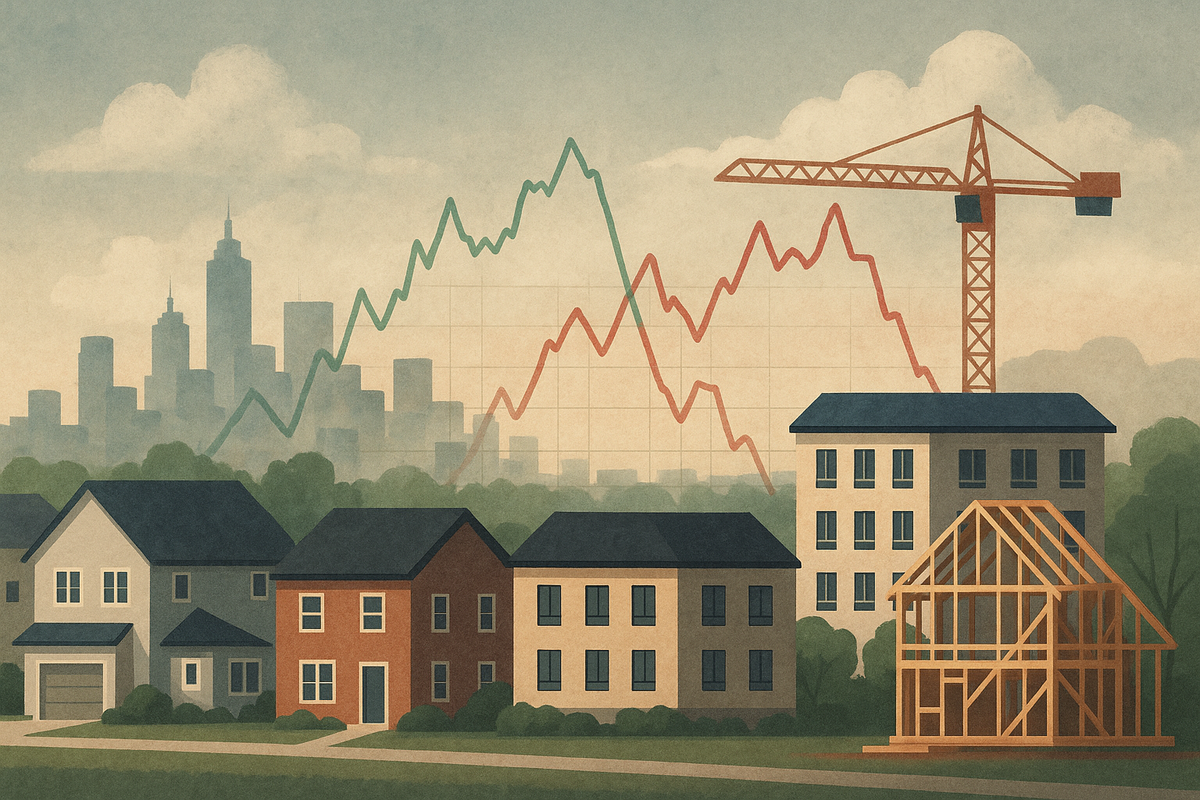Financial News
Housing Market Navigates Choppy Waters: A Mixed Outlook for the US Economy

The U.S. housing market is currently presenting a complex and somewhat contradictory picture, with recent data revealing both a modest uptick in housing starts and a persistent lack of confidence among homebuilders. While July's housing starts offered a glimmer of positive activity, particularly in the multi-family sector, the August NAHB/Wells Fargo Housing Market Index (HMI) underscores ongoing struggles with affordability and weak demand. These mixed signals suggest that the housing sector will likely remain a cautious area for the US economy, with its performance heavily dependent on improvements in affordability and potential shifts in monetary policy.
This dynamic environment has immediate implications for the broader economy. A subdued housing market can act as a significant drag on economic growth, impacting job creation in construction and related industries, and potentially curbing consumer spending. The interplay of rising interest rates, supply-side headwinds, and evolving consumer sentiment creates a challenging landscape for both industry players and prospective homeowners.
Housing Starts Rebound Amidst Lingering Builder Pessimism
The latest data on privately-owned housing starts, released on August 19, 2025, showed a notable increase for July 2025, reaching a seasonally adjusted annual rate of 1,428,000 units. This represents a 5.2% increase from June and a substantial 12.9% increase compared to July 2024. This rebound was largely driven by the multi-family segment, which saw a 9.9% month-over-month rise, while single-family housing starts also experienced a modest increase of 2.8%. Regionally, the South and Midwest recorded significant gains.
However, a forward-looking indicator, building permits, saw a decline of 2.8% month-over-month in July, falling to 1.354 million annualized units. While single-family permits edged up, multi-family permits decreased. This decline in permits suggests that the recent upward trend in starts may not be sustainable in the near future, indicating potential volatility.
In stark contrast to the housing starts data, the NAHB/Wells Fargo Housing Market Index (HMI) for August 2025, released on August 18, 2025, registered 32, a one-point decrease from July's reading. This marks the 16th consecutive month that builder sentiment has remained in negative territory (below 50), signifying that more builders view sales conditions as poor rather than good. Key components of the HMI, such as current sales conditions and sales expectations, also reflected this pessimism.
In an effort to stimulate demand, 37% of builders reported cutting prices in August, and the use of sales incentives increased to 66%, reaching its highest percentage in the post-Covid period. This persistent lack of confidence among homebuilders, despite the recent uptick in starts, highlights the ongoing struggle with housing affordability, elevated mortgage rates, and weak buyer traffic.
Navigating the Shifting Sands: Winners and Losers in the Housing Market
The current housing market dynamics create a clear divide between potential winners and losers. Companies with strong balance sheets and diversified portfolios may be better positioned to weather the storm, while those heavily reliant on new single-family home construction in specific regions could face significant headwinds.
Potential Winners:
- Multi-family Developers and REITs: The strong performance of the multi-family segment in July's housing starts suggests a continued demand for rental properties. Companies like Equity Residential (NYSE: EQR) and AvalonBay Communities (NYSE: AVB), which specialize in multi-family residential real estate, could see sustained demand for their properties, especially in urban centers where affordability challenges push more individuals towards renting.
- Home Improvement Retailers: With fewer new homes being built and existing homeowners potentially opting to renovate rather than move, companies like Home Depot (NYSE: HD) and Lowe's (NYSE: LOW) could benefit from increased spending on home improvement projects.
- Building Material Suppliers (with caution): While overall demand for new construction materials might be subdued, suppliers of materials for multi-family projects or those with strong cost management strategies could fare better. However, the anticipated implementation of lumber tariffs and existing tariffs on steel, aluminum, and copper could increase costs for these companies.
Potential Losers:
- Single-Family Homebuilders: The consistently low NAHB HMI and the high percentage of builders cutting prices and offering incentives point to significant challenges for single-family homebuilders. Companies like D.R. Horton (NYSE: DHI) and Lennar Corporation (NYSE: LEN) may continue to face pressure on their margins and sales volumes due to affordability constraints and weak buyer traffic.
- Mortgage Lenders and Brokers: Elevated mortgage rates directly impact the volume of new home sales and refinancings, leading to reduced business for mortgage lenders and brokers. Companies like Rocket Companies (NYSE: RKT) and United Wholesale Mortgage (NYSE: UWMC) could see continued pressure on their origination volumes.
- Real Estate Agencies: A slowdown in housing transactions directly affects real estate agents and brokerages, leading to fewer commissions. Companies like Anywhere Real Estate Inc. (NYSE: HOUS) could experience reduced revenue in a sluggish market.
Industry Impact and Broader Economic Implications
The current state of the housing market fits into a broader trend of economic uncertainty, primarily driven by persistent inflation and the Federal Reserve's aggressive interest rate hikes. The housing sector, often considered a bellwether for the broader economy, is clearly signaling caution. The mixed signals from housing starts and builder sentiment highlight the delicate balance the economy is trying to maintain.
The potential ripple effects extend beyond the immediate housing and construction industries. A slowdown in homebuilding impacts a vast ecosystem of related businesses, from appliance manufacturers and furniture retailers to landscaping services and moving companies. Reduced consumer spending on these items can further dampen overall economic activity.
Regulatory and policy implications are also significant. The NAHB Chief Economist Robert Dietz has explicitly called for the Federal Reserve to resume lowering the federal funds rate, arguing that current monetary policy is a key impediment to recovery. This highlights the industry's view that policy adjustments are crucial to alleviate affordability challenges and stimulate demand. Furthermore, ongoing supply-side headwinds, including skilled labor shortages and rising material costs, are exacerbated by anticipated lumber tariffs and existing tariffs on other key materials, further restraining homebuilding activity and increasing costs.
Historically, periods of sustained high interest rates and declining builder confidence have often preceded broader economic slowdowns. While the current situation is unique in its specific drivers, the parallels to past cycles of housing market stress are noteworthy. The resilience of the labor market has so far provided some buffer, but a prolonged housing slump could eventually erode consumer confidence and spending, potentially leading to a more significant economic downturn.
What Comes Next: Navigating Uncertainty
The immediate future of the housing market will likely be characterized by continued volatility and a careful watch on key economic indicators. In the short term, the decline in building permits suggests that the recent uptick in housing starts may not be sustainable, and we could see a moderation or even a decline in starts in the coming months. Homebuilders will likely continue to employ price cuts and incentives to attract buyers, further impacting their margins.
Long-term possibilities hinge significantly on the Federal Reserve's monetary policy. A pivot towards interest rate cuts could provide much-needed relief to the housing market, improving affordability and stimulating buyer demand. However, the timing and extent of such cuts remain uncertain, dependent on inflation trends and broader economic performance.
Strategic pivots and adaptations will be crucial for companies in the housing sector. Homebuilders may need to focus on more affordable housing options, explore alternative construction methods to reduce costs, or diversify into other segments like multi-family or build-to-rent. Mortgage lenders may need to innovate with new loan products or focus on niche markets.
Market opportunities may emerge for investors with a long-term perspective, particularly in segments that are less sensitive to interest rate fluctuations or those poised for recovery once affordability improves. Challenges will persist for companies with high debt loads or those heavily exposed to the most vulnerable segments of the market.
Conclusion: Awaiting Clarity in a Shifting Landscape
The U.S. housing market is at a critical juncture, presenting a complex interplay of positive and negative signals. While the recent increase in housing starts offers a glimmer of hope, the persistent pessimism among homebuilders, coupled with declining building permits, underscores the deep-seated challenges of affordability and weak demand. The housing sector's performance will continue to be a key determinant of the broader economic trajectory.
Moving forward, investors should closely monitor several key indicators: the Federal Reserve's monetary policy decisions, particularly any signals regarding interest rate adjustments; the monthly housing starts and building permits data for signs of sustained trends; and the NAHB HMI for shifts in builder sentiment. Additionally, tracking inflation data and consumer confidence will provide crucial insights into the overall economic environment impacting housing.
The lasting impact of this period of uncertainty will depend on how quickly the market can adapt to evolving economic conditions and whether policy makers can provide the necessary support to alleviate affordability pressures. While the path ahead remains uncertain, a careful and informed approach will be essential for all stakeholders in the housing market.
More News
View More




Recent Quotes
View MoreQuotes delayed at least 20 minutes.
By accessing this page, you agree to the Privacy Policy and Terms Of Service.



